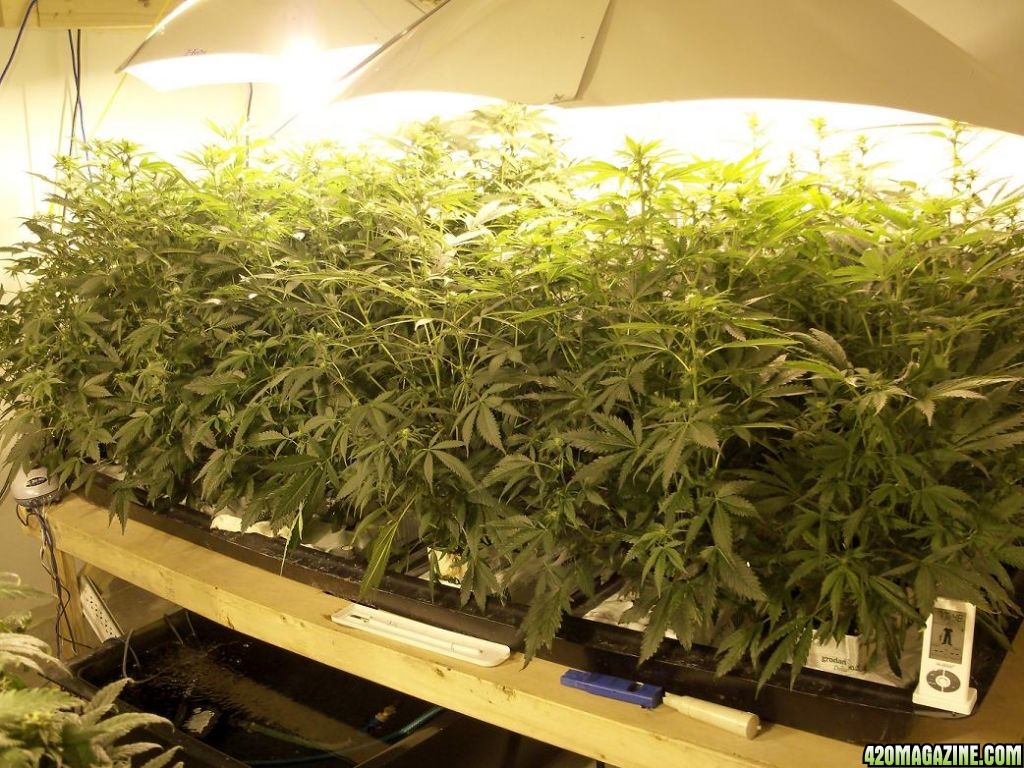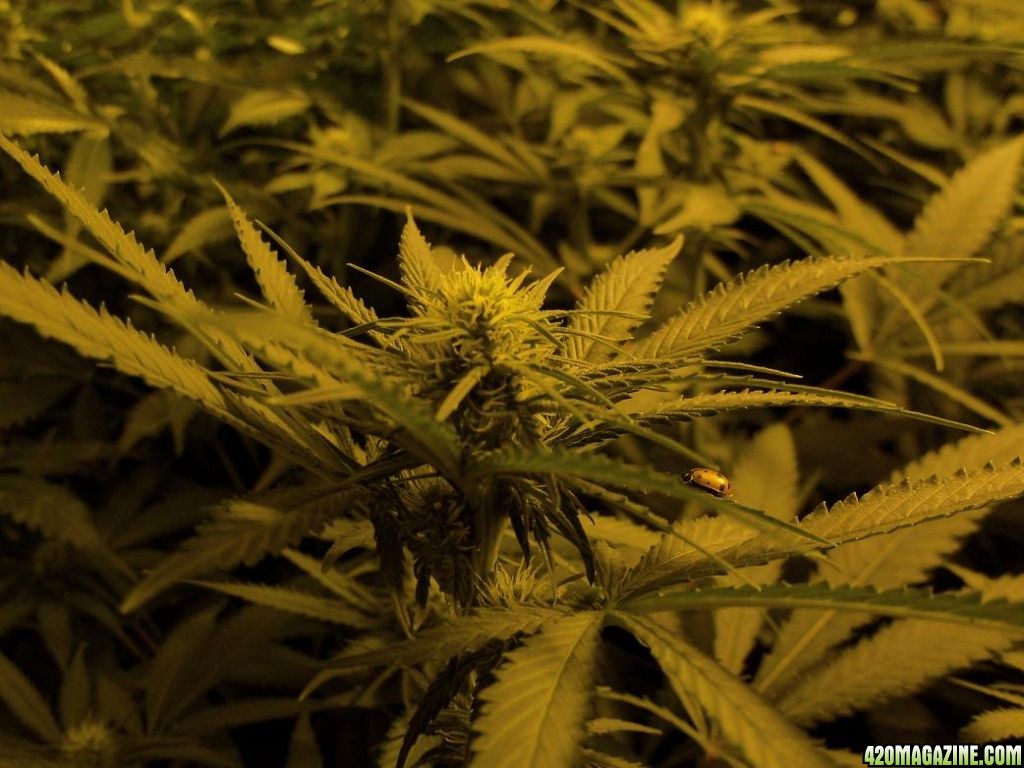Sorry long read:
I suggest getting 33% concentrate, as the crap you get at the pharmacy is full of impurities.
How much? - 3ml/gallon in the rez at change and half that everyday.
Works wonders and in soil too.
Oh and use gloves as it will turn your skin milky white to the touch and it lasts awhile.
How it works?
You can not "cure" pythium. It is a bacteria. It is always present.
You can prevent and "cure" the symptoms of a pythium infection. In this case, "cure" simply means ridding the plant of infectious symptoms. The actual bacteria will still be present.
The key is to make your root zone hospitable to the roots, not to bacteria, usually caused by low oxygen levels in the solution or high temp solutions (which also causes low O2 levels).
Cool nutrient solution temps (68-73 F) and proper aeration will not allow pythium to grow
So we pour hydrogen peroxide into our water, which gives a slight reading of EC or electrical current/conductivity so that needs taking into account.
The H2O2 (hydrogen peroxide) is very unstable in its current form and it quickly breaks down once in the nutrient solution. Essentially, within a short space of time it’s present only in its component form (water and oxygen), and in reaching this form it releases a single oxygen atom.
This oxygen atom is ultra-reactive as well as aggressive. It’s looking for a fight, but instead of looking to cause problems it’s actually on your team.
So the unstable single oxygen atom sets off, looking for mischief to make.
If it comes across another oxygen atom, it attaches itself to the other atom, forming a larger, more stable oxygen molecule, or ion. This gets taken in by the plant through the roots, and benefits growth both above, as well as within the root zone.
If however, the rambunctious oxygen atom comes across an organic molecule, such as a virus, or fungal spore as it waxes & wanes through your nutrient solution, it will attach itself to the pathogen and quite literally oxidise itself, as well as whatever organism it had attached itself to.
And this stuff actually works!
So what this means is not only does H2O2 supply the nutrients (and indirectly, the plants) with a massive boost of pure oxygen ions, it will also play a huge part in keeping your reservoir fresh, highly oxygenated, as well as free from organisms such as Pythium, Fusarium, mould as well as a plethora of other nasties we encounter daily as hydroponic growers.
Not only that but when the crop comes down there is no better cleaning agent to use (albeit in higher concentrations) than hydrogen peroxide. Not only will it clean as effectively as bleach but, as explained earlier it attaches itself to other organic micro-bad guys, and oxidises them into nothingness. They simply cease to exist, leaving your grow room clean, sterile and ready for the next crop.
O2
If it even needed saying, a fresh and regular exposure to pure oxygen will work wonders in how your plants look and “feel”.
Oxygen invigorates, it heals, it’s present (and necessary) in every living form and plants just can’t get enough of it.
With lots of oxygen available nutrient uptake is massively boosted and if the plants getting the nutrients, it will use them.
Also, this extra nutrient, along with a blast of oxygen is going to increase the production of proteins at cell level across the board, especially if the plant is getting plenty of CO2 (the carbon source the plants use to actually “build” themselves). This means thicker stronger stems with shorter inter-nodal spacing, as well as lush deep green healthy foliage.
Which is also better equipped to handle the complicated conversions as a result of the photosynthetic processes the plant carries out, in the creation of the sugars and starch’s necessary to feed it.
As a result of this mad growth, your plants will supply readily, the smaller side branch’s necessary to facilitate a productive run of cuttings.
So, no matter what your chosen growing method is, get some hydrogen peroxide in the grow room.
Either used for oxygenation, or for pathogen destruction and prevention, or as a cleaning agent, H2O2 fills all these roles and more, with aplomb.
I suggest getting 33% concentrate, as the crap you get at the pharmacy is full of impurities.
How much? - 3ml/gallon in the rez at change and half that everyday.
Works wonders and in soil too.
Oh and use gloves as it will turn your skin milky white to the touch and it lasts awhile.
How it works?
You can not "cure" pythium. It is a bacteria. It is always present.
You can prevent and "cure" the symptoms of a pythium infection. In this case, "cure" simply means ridding the plant of infectious symptoms. The actual bacteria will still be present.
The key is to make your root zone hospitable to the roots, not to bacteria, usually caused by low oxygen levels in the solution or high temp solutions (which also causes low O2 levels).
Cool nutrient solution temps (68-73 F) and proper aeration will not allow pythium to grow
So we pour hydrogen peroxide into our water, which gives a slight reading of EC or electrical current/conductivity so that needs taking into account.
The H2O2 (hydrogen peroxide) is very unstable in its current form and it quickly breaks down once in the nutrient solution. Essentially, within a short space of time it’s present only in its component form (water and oxygen), and in reaching this form it releases a single oxygen atom.
This oxygen atom is ultra-reactive as well as aggressive. It’s looking for a fight, but instead of looking to cause problems it’s actually on your team.
So the unstable single oxygen atom sets off, looking for mischief to make.
If it comes across another oxygen atom, it attaches itself to the other atom, forming a larger, more stable oxygen molecule, or ion. This gets taken in by the plant through the roots, and benefits growth both above, as well as within the root zone.
If however, the rambunctious oxygen atom comes across an organic molecule, such as a virus, or fungal spore as it waxes & wanes through your nutrient solution, it will attach itself to the pathogen and quite literally oxidise itself, as well as whatever organism it had attached itself to.
And this stuff actually works!
So what this means is not only does H2O2 supply the nutrients (and indirectly, the plants) with a massive boost of pure oxygen ions, it will also play a huge part in keeping your reservoir fresh, highly oxygenated, as well as free from organisms such as Pythium, Fusarium, mould as well as a plethora of other nasties we encounter daily as hydroponic growers.
Not only that but when the crop comes down there is no better cleaning agent to use (albeit in higher concentrations) than hydrogen peroxide. Not only will it clean as effectively as bleach but, as explained earlier it attaches itself to other organic micro-bad guys, and oxidises them into nothingness. They simply cease to exist, leaving your grow room clean, sterile and ready for the next crop.
O2
If it even needed saying, a fresh and regular exposure to pure oxygen will work wonders in how your plants look and “feel”.
Oxygen invigorates, it heals, it’s present (and necessary) in every living form and plants just can’t get enough of it.
With lots of oxygen available nutrient uptake is massively boosted and if the plants getting the nutrients, it will use them.
Also, this extra nutrient, along with a blast of oxygen is going to increase the production of proteins at cell level across the board, especially if the plant is getting plenty of CO2 (the carbon source the plants use to actually “build” themselves). This means thicker stronger stems with shorter inter-nodal spacing, as well as lush deep green healthy foliage.
Which is also better equipped to handle the complicated conversions as a result of the photosynthetic processes the plant carries out, in the creation of the sugars and starch’s necessary to feed it.
As a result of this mad growth, your plants will supply readily, the smaller side branch’s necessary to facilitate a productive run of cuttings.
So, no matter what your chosen growing method is, get some hydrogen peroxide in the grow room.
Either used for oxygenation, or for pathogen destruction and prevention, or as a cleaning agent, H2O2 fills all these roles and more, with aplomb.




 yep. chlorine from your tapwater can also kill em' off depending on the concentration. you can filter it or set it out overnight to lose the chlorine. i think you can also get some liquid drops that remove it, but i havent looked too much into that myself.
yep. chlorine from your tapwater can also kill em' off depending on the concentration. you can filter it or set it out overnight to lose the chlorine. i think you can also get some liquid drops that remove it, but i havent looked too much into that myself.






 H2O2 is a great! +REP
H2O2 is a great! +REP